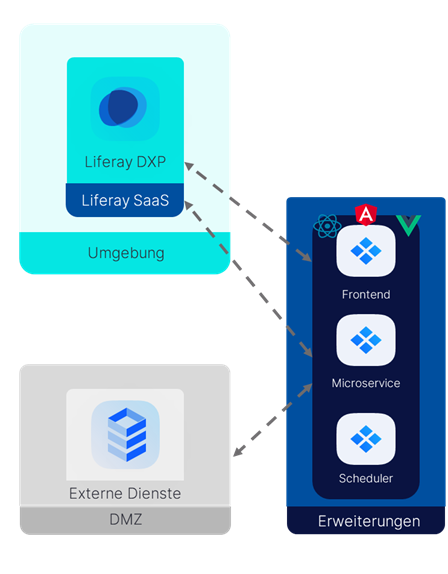Liferay DXP has been a trusted platform for enterprise portals and digital business processes for years. Traditionally, applications and extensions in Liferay were built using Java-based portlets with Java Server Faces (JSF)/JSP and OSGi modules. While this approach worked well for a long time, it now presents growing challenges.
The big question for software architects and decision-makers: Stick with Java technologies or move to modern solutions like React or Angular for the frontend and Spring Boot for the backend?
In this article, you'll discover:
- The challenges of Java-based development in Liferay.
- Why modern technologies offer a smarter alternative.
- The key steps to future-proof your architecture.
Challenges of Java-based technologies in Liferay
For years, Java portlets built with JSF or JSP have been the backbone of portal applications. This approach offers tight API integration, allowing developers to build applications quickly and efficiently.
But here’s the challenge: Every Liferay update requires adjustments to the Java code. Because of this tight coupling, upgrading to a new Liferay version takes significant effort. In the past, updates were rare and required only minor customizations, so this wasn’t a major issue.
That’s no longer the case. Instead of releasing updates every 2–3 years, Liferay now follows a quarterly update cycle. This shift brings greater flexibility and faster responses to changing customer and market needs—but it also increases the complexity of maintenance.
Maintenance effort and developer productivity
Java-based technologies like JSF require deep expertise in both Java and Liferay. In our experience, new developers face a steep learning curve before they can contribute productively.
The industry is shifting toward decoupled applications that communicate through clear interfaces. Developers now favor modern web frameworks like React or Angular for frontends and Spring Boot for backends. While Java-based technologies have been reliable, they’re becoming less common in new projects—making skilled developers harder to find.
Availability of developers
Developers gravitate toward modern, fast-evolving technologies rather than older, complex frameworks like JSF.
As a result, finding front-end developers skilled in React or Angular is much easier than sourcing experts in Java and portal technologies.
Liferay as a platform for modern architectures
Liferay DXP now supports a more flexible, decoupled approach with its client extension framework. This allows developers to extend Liferay without modifying the platform’s core, making it easier to build and maintain applications.
For years, Liferay has been optimizing its architecture for cloud-based deployments. Key innovations include client extensions, the object framework, and an extension environment for back-end services.
Liferay continues to handle core functions—such as authentication, web content, navigation, and document management—while developers focus on building business-specific solutions. These extensions operate as independent services or web components, no longer tightly coupled to the Liferay core.
Advantages of client extensions over traditional extensions
Traditional Liferay plugins, such as OSGi modules, often rely on internal Liferay APIs and services. When these APIs change in a new Liferay version, developers must review and update their code, recompile, and redeploy—making upgrades time-consuming and complex.
Client extensions eliminate this dependency. They run independently of Liferay and don’t require migration during upgrades. By leveraging standardized interfaces like REST, GraphQL, and OAuth2/OpenID Connect, they remain fully functional even after a Liferay update.
This means faster, more cost-effective upgrades and the ability to keep pace with Liferay’s rapid innovation—without the hassle of constant adaptation.

Liferay Client Extensions decouple individual customizations
Recommendations for architects and decision-makers
Migrating from Java-based applications to the Client Extension Framework is a strategic move that requires careful planning. It involves technological shifts, organizational changes, and investment in team development—but the benefits are clear. Companies that adopt modern architectures gain greater flexibility, easier maintenance, and faster innovation cycles.
For existing JSF applications, consider a gradual migration to minimize risk. For new projects, a decoupled architecture should be the default choice.
Liferay allows for an incremental transition, replacing individual modules with React or Angular components instead of overhauling the entire application at once. During the transition, JSF and modern front-end technologies can run in parallel, with older components phased out over time. This step-by-step approach reduces risk and streamlines the modernization process.
Bringing your team along on the journey
Shifting to modern front-end technologies isn’t just a technical change—it’s a team transformation. Providing targeted training in React, Angular, or Spring Boot ensures your developers have the skills they need.
Modern front-end applications also require a different build and deployment strategy than traditional Java server applications. To fully leverage these technologies, teams should adopt automated testing, continuous integration, and container-based deployments from the start.
By combining technical upgrades with team development, organizations can ensure a smooth, successful migration—both technologically and operationally.
Conclusion
Replacing Java technologies like JSF and JSP in Liferay isn’t just an upgrade—it’s a strategic move to stay competitive. Tight coupling with Liferay makes updates and maintenance challenging, while modern microservice architectures offer greater flexibility, better performance, and faster development.
Liferay fully supports this approach, giving companies the perfect opportunity to future-proof their applications and embrace the cloud.
Now’s the time to make the switch. We’re here to help you take the leap into the future!
As a long-standing Liferay Partner of the Year (EMEA) 2024, USU brings deep expertise in analysis, design, implementation, and migration. Let’s modernize your Liferay platform together!